
Every time we want to escape the hustle and bustle of Delhi city, we run for cover to the nearest haven -- the Jim Corbett National Park in Uttarakhand. The fun starts the moment we board the train. The Ranikhet Express from Delhi to Kathgodam has limited coaches for Ramnagar (a town about nine km from Corbett territory). The train leaves from Old Delhi Railway station at about 10.45 pm, and reaches Ramnagar at about 5 am the following morning. The moment you move out the city, you start feeling the change in the air -- fresh and chilly.
The resorts around
Most hotels/ resorts near Corbett National Park are located at Dhikuli, but they are rather expensive. However, they do provide cozy and fancy accommodations just outside the park. Almost all hotels are located close to the Kosi river which just roars during the holiday season (post-monsoon).
We call this trip a fancy one because a real jungle safari is not supposed to be that cozy. The Dhikuli-Ramnagar area is located on the outer boundaries of the Corbett forest area. To see some real-time jungle activity, as described in Corbett's stories, plan a visit to the Dhikala area. Enlivened by the Ramganga river (the lifeline of the entire jungle), you have better chances of spotting tuskers and tigers.
If you are planning a trip to Dhikala, visit the KMVN site for more details (https://www.kmvn.org/).
Note: The jungle is closed for safaris during the monsoons. The best time to visit is between November and April. It is advisable to book your hotel in advance specially during weekends.
We prefer to stay at the Tiger Camp, a very hospitable resort in Dhikuli. They arrange pick-ups from the railway station in Maruti Gyspie cars, which makes the early morning ride quite an eye-opener (literally). If you are covered up with warm clothes you might just enjoy the ride and the chilly morning breeze.
Tiger Camp has cozy cottages for accommodation and, I must mention, a buffet dinner at the Gol ghar (gazebo). The menu is mainly Indian. Not sure if they have mastered the facilities, but almost every hotel/ resort in that belt boasts of river-view cottages and similar eating arrangements. However, this hotel also has Dhanu the guide/ tour manager/ naturalist, a seasoned jungle and bird-watching expert who just pours his passion into his profession. You can also enjoy the evening slideshows he arranges while sitting around the bonfire. His jungle stories, animal tales and tiger encounters will certainly leave you more educated about animals, trees and birds in the area.
For those planning a two-day trip to Corbett, we would suggest these five must-dos.
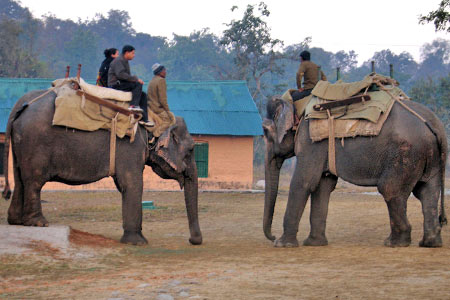
From the Dhikuli area, day trips to the park (limited in number) are arranged from the Bijrani gate every morning and evening. Keep your fingers crossed if you're hoping to spot a tiger. The guide (compulsory with every jeep) may keep you hooked for sometime by showing tiger pugmarks and scratches. However, be ready to see lots of langurs, deer, and birds. Much much more than what you will see in your city zoo!
Note: For safaris, permission needs to be obtained from the forest department at the Bijrani gate. Since there are only a limited number of jeep safaris per day it is better to book the safari along with your hotel booking; they manage it better that way.
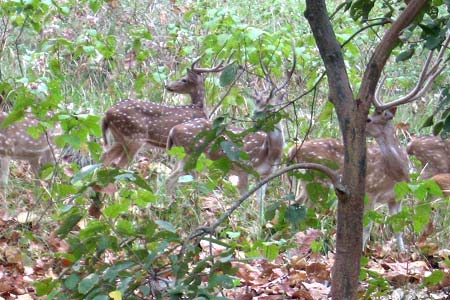
From Dhikuli, you may also plan a two-hour trip to the Corbett Museum in Kaladhungi. This museum is at the place where the great hunter stayed. Apart from a small statue of Jim Corbett, you can enjoy an illustrated museum with information about Corbett and other national parks and general geography. In another room, you will see stuffed tigers that were hunted decades ago and are now in a preserved state.
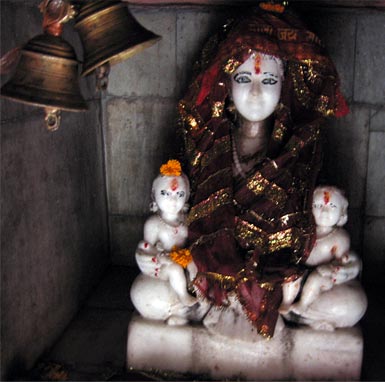
On the way back from the jungle, do visit the Garjia temple. Located on a small hillock, the temple is surrounded by the Kosi river. Locals from nearby areas come to worship the devi, who is also said to have protected the temple from being washed away during the floods in the Kosi river many years ago.
The temple gets very crowded during the festival of Dusshera in September/ October. There is a very small Shiv temple at the base of the hill as well. A few metres away, across the river, is the Bhairon temple. People visit this temple after visiting the main temple. To reach the Bhairon temple you have to cross the river over a footbridge made of cement stacks.
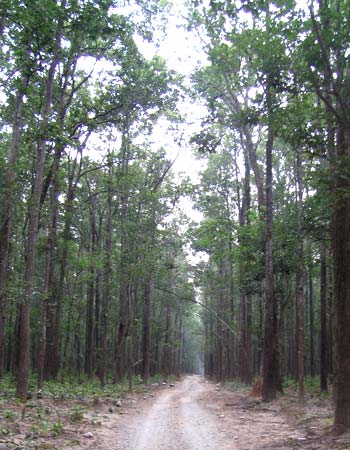
About 22 km from Ramnagar, on the way to Nainital, is this pristine forest area where you will rarely come across an animal other than monkeys and deer. And that is exactly why this place is recommended -- the silence and the dense expanse of the forest is what makes a visit here worthwhile.
Then there is also a little temple and ashram tucked away in between sal, kattha, and many other tress. According to legend, the ashram is where Sita is said to have lived with her sons Luv and Kush during exile. The temple is very quiet and unique in every sense. Plan a mid-afternoon trip, as going back through the lonely jungle might seem challenging after sun down.
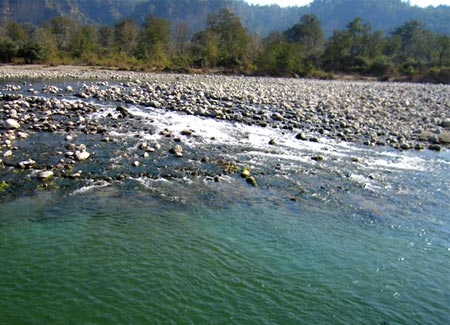
A walk by the Kosi river usually in the morning and evening is very relaxing. The mood and sounds of the river will entrance you as it hits the stones and boulders.